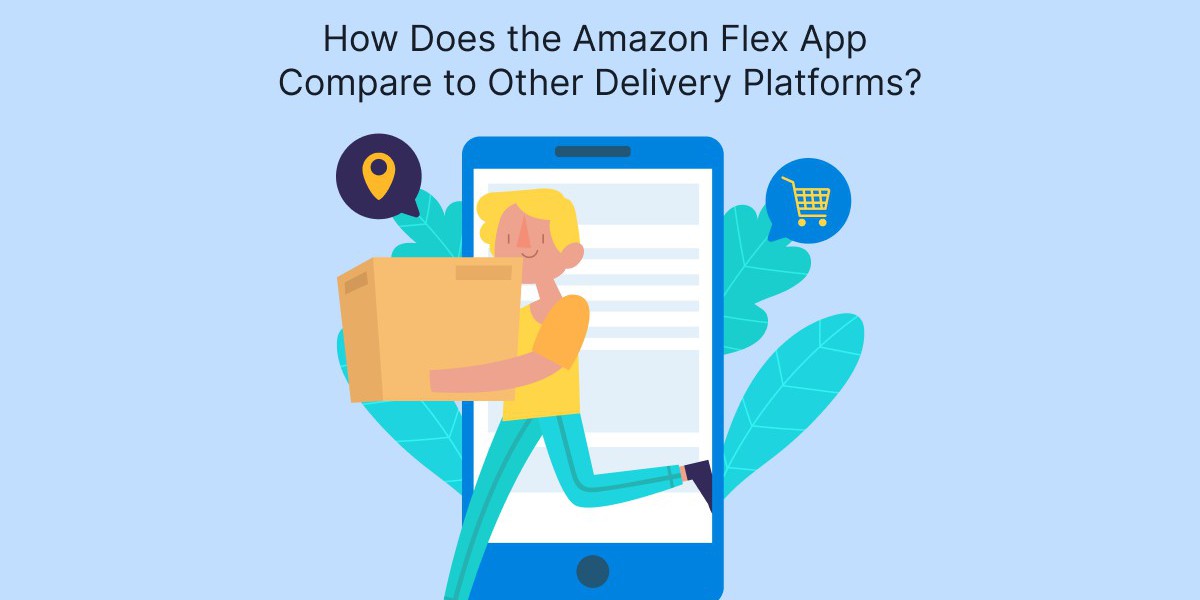In the rapidly evolving landscape of gig economy jobs, delivery platforms have become increasingly popular among individuals looking for flexible work opportunities. The Amazon Flex app allows drivers to deliver packages for Amazon, providing a unique blend of flexibility and competitive pay. However, it's essential to understand how Amazon Flex stacks up against other delivery platforms, such as DoorDash, Uber Eats, and Instacart. In this blog post, we will explore the key features, advantages, and disadvantages of the Amazon Flex app compared to these other platforms.
Amazon Flex Overview
What is Amazon Flex?
Amazon Flex is a delivery service that allows individuals to use their own vehicles to deliver packages for Amazon. Drivers, known as delivery partners, can choose their working hours and are paid per delivery block, typically lasting two to four hours. The app provides drivers with navigation, real-time tracking, and package management features.
Amazon Flex Key Features
- Flexible Scheduling : Drivers can select delivery blocks that fit their schedules, offering unparalleled flexibility compared to traditional jobs.
- Competitive Pay : Earnings typically range from $18 to $25 per hour, depending on location and demand.
- Package Variety : Drivers can deliver a wide range of Amazon products, from small packages to larger items.
- Earnings Tracking: Drivers can track their pay directly within the app, including base pay, tips, and incentives.
Comparison with Other Delivery Platforms
1. DoorDash
Overview
DoorDash is a food delivery platform that connects customers with local restaurants. Drivers, known as Dashers, can earn money by delivering food orders.
Key Features
- On-Demand Delivery : Dashers can pick up and deliver orders as they come in, providing real-time flexibility.
- Promotions and Incentives : DoorDash frequently offers promotions, peak pay bonuses, and challenges that can increase earnings.
Advantages of DoorDash
- Wider Delivery Scope : While Amazon Flex focuses on package delivery, DoorDash offers food delivery, groceries, and convenience store items, catering to a broader market.
- No Scheduled Blocks : Dashers can choose to work whenever they want without being locked into specific delivery blocks, allowing for more spontaneity.
Disadvantages of DoorDash
- Variable Pay : Earnings can fluctuate widely based on demand and time of day, and drivers are sometimes subject to lower pay during non-peak hours.
- Increased Competition : Many Dashers compete for the same orders, which can lead to longer wait times for deliveries.
2. UberEats
Overview
UberEats is another popular food delivery service that allows drivers to deliver meals from local restaurants. It similarly to DoorDash but is part of the larger Uber ecosystem operates.
Key Features
- Flexible Scheduling : Drivers can log in and out of the app whenever they want, providing a flexible work environment.
- User-Friendly App : The UberEats app is intuitive and provides drivers with easy navigation and tracking features.
Uber Eats Advantages
- Integrated Platform : Being part of the Uber ecosystem means drivers can switch between ridesharing and food delivery, maximizing earning potential.
- Predictable Earnings : While there can be fluctuations, many drivers report more predictable earnings through tips and promotions.
Disadvantages of Uber Eats
- Restaurant Wait Times : Drivers may experience delays while waiting for food orders to be prepared, which can affect overall earnings per hour.
- Lower Base Pay : Some drivers find the base pay to be lower than that of Amazon Flex, especially during non-peak hours.
3. Instacart
Overview
Instacart is a grocery delivery service that connects shoppers with local grocery stores. Drivers, referred to as shoppers, can either shop for groceries or simply deliver them.
Key Features
- Variety of Tasks : Drivers can choose to shop for groceries or just deliver them, providing options based on personal preferences.
- Batch Deliveries : Instacart allows drivers to take multiple orders at once, potentially increasing earnings during busy times.
Advantages of Instacart
- Increased Earnings Potential : Shopping for groceries can lead to higher earnings through tips, especially if drivers provide excellent customer service.
- Flexible Task Options : Drivers can choose between shopping and delivery, allowing for greater variety in work tasks.
Disadvantages of Instacart
- Physically Demanding : Grocery shopping can be more physically demanding than simple package delivery, requiring lifting and navigating store layouts.
- Scheduling Challenges : Instacart may have stricter scheduling policies compared to the more flexible approach of Amazon Flex.
Comparing Earnings Potential
1. Pay Structure
Amazon Flex
Amazon Flex drivers earn between $18 and $25 per hour, paid per delivery block. This structure is clear and allows drivers to estimate their earnings based on the number of blocks they choose to work.
DoorDash and Uber Eats
Both DoorDash and Uber Eats have a pay structure that combines base pay, tips, and potential bonuses. However, earnings can fluctuate significantly depending on demand and competition, making it harder to predict weekly income.
Instacart
Instacart drivers can earn money per delivery, with potential bonuses for completing multiple orders. However, the income may vary based on the number of customers served and tips received, making it less predictable.
2. Flexibility and Working Hours
Amazon Flex
Amazon Flex offers drivers the flexibility to choose specific delivery blocks, allowing them to plan their work around other commitments. However, these blocks must be scheduled in advance.
DoorDash and Uber Eats
Both platforms provide real-time flexibility, allowing drivers to work on-demand without needing to schedule shifts. This spontaneity can be beneficial for those looking for immediate work opportunities.
Instacart
While Instacart provides flexibility in choosing tasks, the need to shop can make the process longer compared to simply picking up and delivering packages. This may be a consideration for those seeking quicker deliveries.
Conclusion
Choosing the right delivery platform depends on individual preferences, work styles, and financial goals. Amazon Flex offers a structured and predictable earning potential, which is ideal for those looking to commit specific hours to package delivery. In contrast, DoorDash and Uber Eats provide more spontaneity, allowing drivers to work whenever they choose, albeit with fluctuating earnings. Discover how the Amazon Flex app stands out among other delivery platforms. Learn from experts in the on-demand app development company industry.
Instacart appeals to those who prefer grocery shopping as part of their work, but it comes with its own set of physical demands and scheduling considerations. Ultimately, evaluating the pros and cons of each platform will help you determine the best fit for your lifestyle and financial objectives.
By understanding the features, earnings potential, and flexibility of Amazon Flex compared to other delivery platforms, you can make an informed decision that aligns with your needs. Whichever platform you choose, embracing the gig economy offers exciting opportunities for supplemental income and flexible work arrangements.



